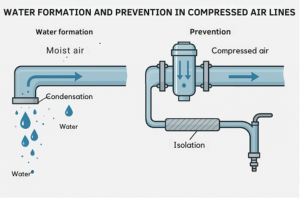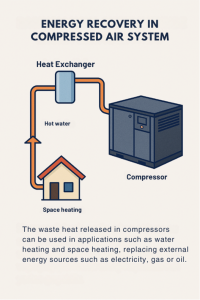Top 10 Frequently Asked Questions About Compressed Air

Since the Industrial Revolution, many things have changed—but the importance of compressed air has remained constant. However, many people still have various questions about this widely used energy source. If you’re curious too, the answers provided here can help you understand everything you want to know about compressed air. We’ll explore the 10 most frequently asked questions about compressed air systems and their applications, covering a wide range-from how it’s generated to safety techniques, energy savings, and maintenance tips. Our goal is to provide clear and easy-to-understand answers to all your questions so you can better grasp this valuable technology. Get ready to explore everything you’ve ever wanted to know about compressed air!
1- In Which Industries Is Compressed Air Used?
Compressed air is like the invisible hero of modern industry and plays a vital role across many sectors. It’s commonly used in the automotive industry in spray painting systems and assembly lines, in the food industry for packaging and bottling, and in the textile sector for weaving looms and fabric cutting. It’s also essential in the chemical industry for mixing and transfer processes. In the energy sector, it’s used in pneumatic control systems and equipment cleaning. In healthcare, it powers surgical instruments and supports various lab applications.
2- What Is Compressed Air Made Of?
Compressed air is made from the same air you breathe in and out—only it’s compressed into a smaller volume and kept under pressure. Atmospheric air, with its basic components, is used in compressed air systems. Typically, atmospheric air consists of about 78% nitrogen, 20–21% oxygen, and 1–2% moisture, carbon dioxide, and other gases. These proportions remain the same in compressed air, but when pressure is applied, the gases become more concentrated, making them useful for various industrial applications.
3 – Why Is Moisture a Problem in Compressed Air Systems?
Moisture is a common and serious issue in compressed air systems. It can cause corrosion, contamination, and decreased efficiency in industrial processes. Corrosion in metal components can erode the inner surfaces of pipelines and even cause leaks. Moisture leads to air leaks and pressure drops, reducing energy efficiency. It can also accumulate inside pneumatic tools and valves, disrupting functionality and causing premature wear. Additionally, it can damage equipment and lower product quality. In sensitive production environments, moisture can cause droplets on products or lead to defects like stains and bubbles in painting and coating applications.
 4 – How Is Air Compressed?
4 – How Is Air Compressed?
Atmospheric gas is compressed in two stages. In pneumatic systems, air is stored in a piston, tank, or similar enclosure and pressurized using various mechanisms. In the initial phase, the volume inside the enclosure is reduced, pushing air particles closer together and concentrating them. In the final phase, the compressed gas is stored in this state until it’s ready for use.
The simplest industrial method of air compression involves piston compressors, where a piston pushes air downward inside a cylinder. When released, the stored compressed air expands and provides the energy needed for different operations.
How Is Air Compressed?
Pistons aren’t the only method for compressing air. In industrial settings, various compression technologies are used, each with its pros and cons. For example, rotary screw compressors use twin rotating screws to compress air by driving it downward.
5 – What Are the Uses of Compressed Air?
Compressed air is an essential tool in modern industry with wide applications across many sectors. As a power source, it can operate pneumatic tools and production equipment. This makes it safer and more flexible than electric tools in certain environments. Equipment and tools powered by compressed air are widely used in construction, tire services, mechanical repair, maintenance, factory production, industrial processes, and vehicle safety systems. In the automotive industry, it’s heavily used in assembly lines, painting, and quality control processes.
6 – Should I Use a Filter in My Compressed Air Line? What Are the Risks of Not Using One?
Yes, using a filter in your compressed air line is recommended. Filters reduce the amount of oil and particles in the system, preventing corrosion in pipelines and protecting end-use equipment. Without filters, production disruptions and increased operational costs may occur. Dirty air decreases machine efficiency and can cause breakdowns, increasing energy consumption and costs.
7 – Why Should Compressed Air Be Dried?
The moisture level in air varies with ambient temperature. Warmer air holds more moisture, while colder air holds less. This natural phenomenon causes issues in compressed air systems. When air is compressed, its moisture condenses into liquid, leading to equipment damage, rust, and reduced product quality.
For example, compressing air at 25°C with 70% relative humidity to 8 bar pressure and 150 L/s flow can introduce about 8 liters of water into the system per hour. This condensation can cause malfunctions, reduce device lifespan, and increase repair costs in precision industrial applications.
 8 – Why Does Water Form in Compressed Air Lines and How Can It Be Prevented?
8 – Why Does Water Form in Compressed Air Lines and How Can It Be Prevented?
Atmospheric air naturally contains water vapor, which varies with temperature and humidity. During compression:
Volume decreases, pressure increases.
Temperature rises (isentropic compression).
As air cools (especially in an aftercooler), it drops below its moisture-holding capacity.
This causes it to reach the dew point.
Condensation occurs, mixing liquid water into the compressed air line.
Atmospheric air naturally contains water vapor, which varies with temperature and humidity.
As this water travels through the system:
It collects at the bottom of pipes.
It causes corrosion and clogging in valves and pneumatic equipment.
It can lead to product quality issues in production lines.
Various technical solutions are applied to prevent problems caused by humidity in compressed air systems. The hot air coming out of the compressor contains a significant amount of water vapor. An aftercooler is used to cool this air and provide condensation. Thus, a large portion of the water is separated at the beginning of the system.
Dryers come into play for moisture that cannot be removed from the system by condensation. Refrigerated dryers reduce the temperature of the air and allow it to reach the dew point, and a dew point of +3˚C is generally achieved. Adsorption dryers are preferred in sensitive applications that require lower humidity. These dryers can provide dew points between -20˚C and -70˚C. In order to prevent condensation caused by external factors that may occur in the pipes, insulation should be applied and the installation should be laid with an appropriate slope. Drain valves should be placed at the lowest points of the lines to facilitate the discharge of accumulated water.
9 – Can Compressed Air Tanks Explode?
While rare, compressed air receiver tanks can explode-typically due to neglect in maintenance. Despite safety measures, lack of upkeep poses serious risks. In industrial environments, compressed air systems require regular inspections.
The most common cause of tank explosions is corrosion, resulting from metal fatigue or structural weakening. When operators fail to drain accumulated water, corrosion increases and the tank may weaken, allowing pressurized air to escape. To ensure safe operation, periodic maintenance, regular drainage, and annual inspections are essential.
10 – How Is Energy Recovered in Compressed Air Systems?
The waste energy from compressors can replace external heat sources like electricity, gas, or oil. This waste heat can be collected via heat exchangers and used for hot water generation, space heating, or industrial processes. With a well-designed system, more than 90% of the energy supplied to a compressor can be recovered as usable heat. This is usually done using air- or water-cooled heat exchangers. In water-cooled systems, the water used to cool compressor oil absorbs heat and can reach 70–90°C, making it suitable for heating purposes.
Kompresörler çalışırken havayı sıkıştırmak için elektrik enerjisini kullanır.
Compressors use electrical energy to compress air while operating. However, more than 90% of this energy is converted into heat and is lost as waste energy in the environment. When this heat is recovered with appropriate systems, it can be used in areas such as water heating, space heating or process heating.
 How it works:
How it works:
Heat from the compressor motor and air compression is absorbed by oil.
Hot oil is passed through a heat exchanger, transferring heat to the surrounding fluid (usually water).
Heated water is then directed to:
Facility sinks, showers, and washing lines.
Radiators for office/workshop heating.
Pre-heating in production processes.
Example:
- Operating 8 hours/day, it generates 60–70 kWh of heat/hour.
- That’s 500–550 kWh per day—enough to:
- Heat 1,500 liters of water from 30°C to 60°C
- Warm approximately 50 m² of office space in winter

